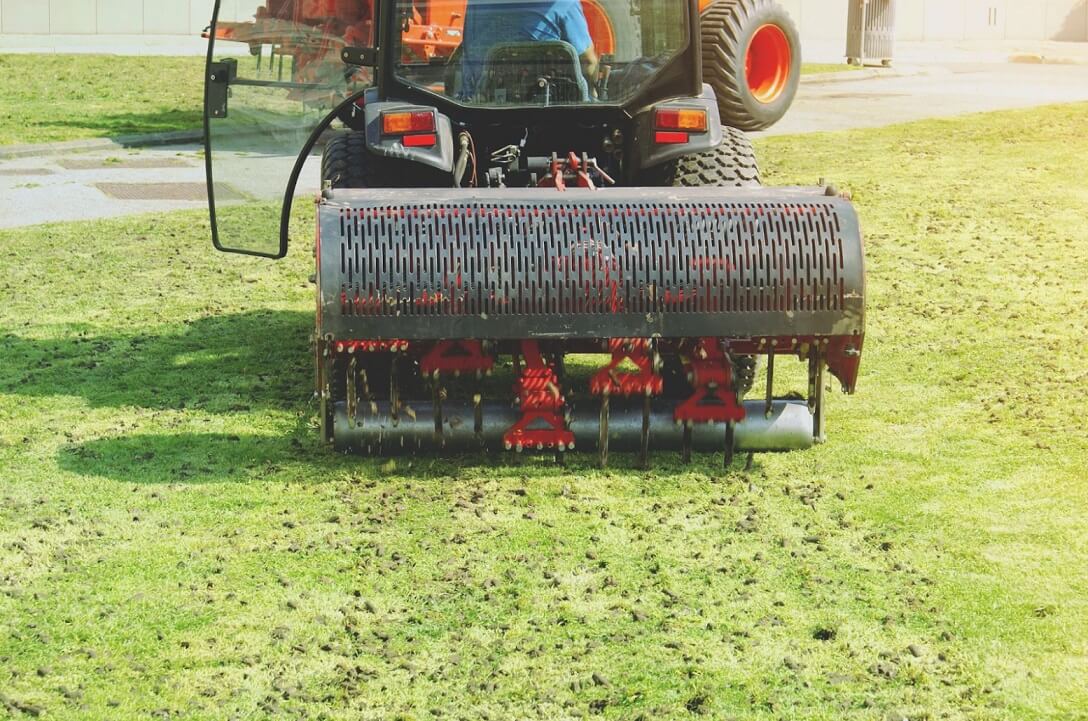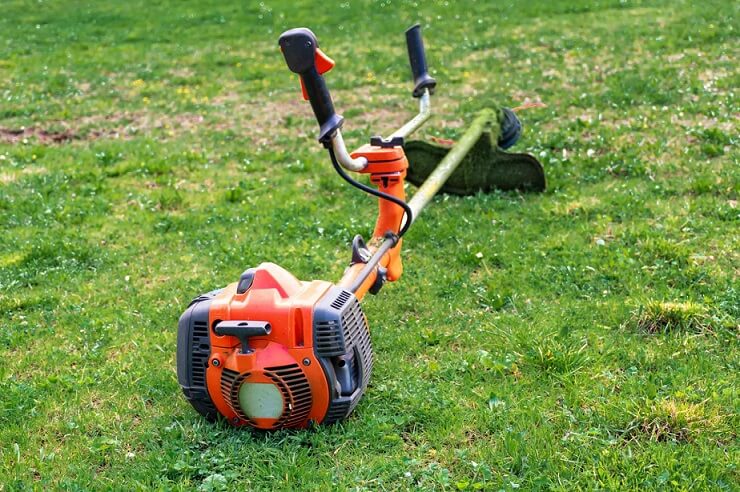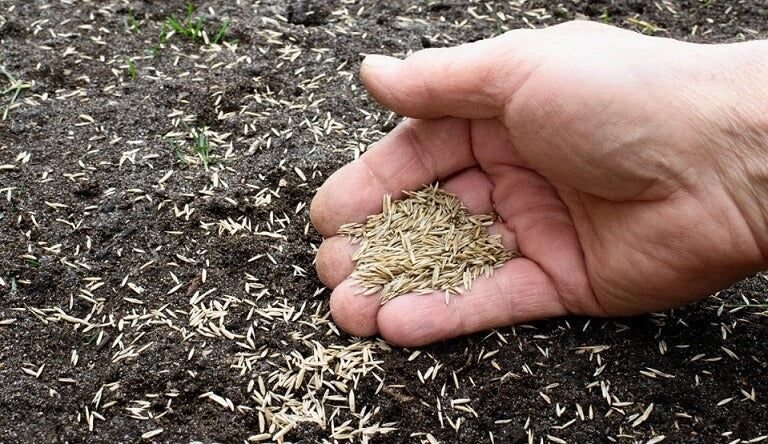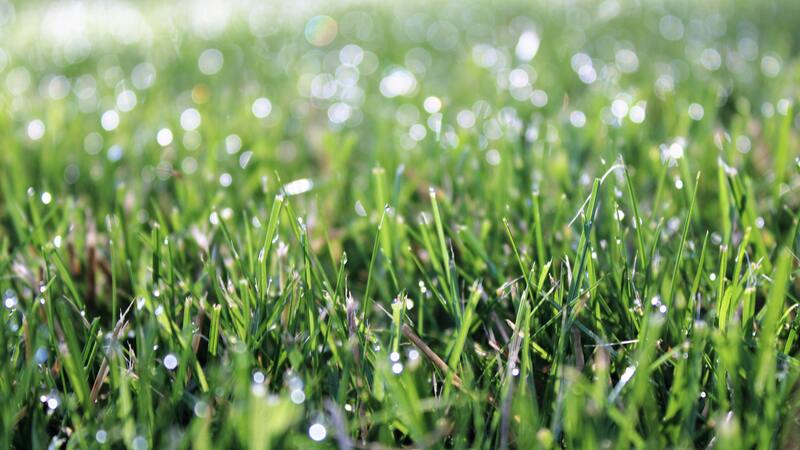Planted or planning to plant new seeds? You might have heard that new grass needs more care and water than an established lawn. The most common confusion is how long to water it so it grows well.
Your concern makes sense. New seeds do need more water, but not at the same level throughout. Watering time and frequency change as the seed moves from germination to sprouting and early growth. You have to adjust as it develops. But how?
This guide explains how long to water new grass seed at each stage, how to measure your sprinkler output, and the factors that affect watering duration so you can get a healthy lawn.
Measuring the Water Output of a Sprinkler
Sprinkler output rate determines how quickly the soil gets the needed moisture. Without this figure, any “minutes per session” advice is just guesswork.
The simplest way to measure output is with a basic container test. Place multiple straight-sided containers (like a small can or plastic cup) on the lawn at different points. Run your sprinkler for 15 minutes. After that, measure the water depth collected in the containers and take their average.
Use this to calculate the output rate:
Sprinkler Output (in/hr) = [Depth of water in cans (inches) × 60] / Time (Minutes)
For example, if your sprinkler adds 0.25 inches in 15 minutes:
(0.25 × 60) / 15 = 1 inch per hour
In most watering recommendations, we’ll assume a sprinkler output of 1 inch per hour. If your calculation differs, just adjust the watering time up or down accordingly.

Water Requirements During Different Stages
A new seed does need more water, but the amount is not the same at every stage. Early stages require more water, and the amount decreases as it gradually moves towards the growth stages.
Pre-Germination
This stage starts even before the seed goes in. The soil should already carry moisture deep down, around 6 to 8 inches. If the soil is dry underneath, roots will struggle to reach down later. Lightly water the area for several days before seeding until the moisture reaches that depth.

Germination (Week 1 to 2)
This is when the seed absorbs water and begins its internal growth. At this point, even a short dry spell can stop progress. Water lightly several times a day to keep the surface constantly moist
- Water 2 to 4 times a day
- Duration each time: 5 to 10 minutes
- Daily total: about ⅛ to ¼ inch of water
Sprouting (Week 2 to 4)
This is when you see the tiny green grass tips. Roots are still shallow, but now they’re reaching downward. Start watering a little longer, but less often.
- Frequency: 1 to 2 times a day
- Duration: 10 to 20 minutes each
- Aim to keep moisture reaching 2 to 3 inches deep

Transition (Week 4 and Onward)
By this time, most types of seeds would turn into grass with roots that can handle deeper watering. It’s time to shift toward a more regular lawn care schedule.
- Frequency: Every other day at first
- Duration: 20 to 40 minutes per session
By week 6, you should transition fully to standard lawn watering, where you have to provide 1 to 1.5 inches of water per week in 1 to 2 sessions.

How Long Does It Take for a Seed to Grow Completely?
Grass seed does not sprout overnight. Depending on the grass type, soil condition, and weather, germination can take anywhere from 5 to 30 days. Different grass varieties have their own natural pace, so the most reliable way to estimate is by looking at the grass type you planted.
|
Grass Type |
Germination Time |
|
Perennial Ryegrass |
5 to 10 days |
|
Fine Fescue |
7 to 14 days |
|
Tall Fescue |
10 to 14 days |
|
Bermudagrass |
10 to 30 days |
|
St. Augustinegrass |
10 to 30 days |
|
Zoysiagrass |
14 to 21 days |
|
Centipedegrass |
14 to 21 days |
|
Kentucky Bluegrass |
14 to 30 days |
Factors Affecting Watering Duration
The watering durations mentioned earlier are subject to change based on local variables, such as the sprinkler’s output, the soil type under the seed, the weather, how much sun or shade hits the lawn, and or the slope of the terrain. Let’s break down each factor.
Sprinkler Output
How much water your sprinkler delivers changes everything. For example, a slower-output sprinkler might take 5–10 minutes to moisten the top 1–2 inches of soil, while a high-output one might do it in half the time. If your sprinkler delivers water at 1 inch per hour of precipitation rate, you will need roughly 5–10 minutes for ~ ⅛ to ¼ inch of water during germination.

Lawn Soil Type
Each soil has a different capability of holding and draining water. For instance, sandy soils drain quickly and lose moisture fast. To grow seeds on such soil, you need to water more frequently (2 to 4 times a day) but for shorter sessions (5 to 10 minutes) early on.
Clay soils hold water longer and drain slowly. For these soils, you may reduce the number of sessions, but avoid over-saturation. Loam or balanced mixes offer an ideal middle ground, and their time duration is similar to what we have recommended in general.
Weather Conditions
Weather overrides almost everything else. Hot, dry, and windy conditions demand more frequent watering because of higher evaporation rates. When it’s cloudy or rainy, you can reduce frequency because the soil stays moist longer. If you’ve had heavy rainfall, you may skip a session altogether.
Sun and Shade
Not all parts of the lawn dry at the same pace. Areas that sit in full sun lose moisture quickly, especially south- or west-facing spots that get the strongest afternoon light. For these areas, either follow slightly longer watering sessions or arrange one extra short session during hotter days.
Lawn Slope
If your lawn slopes, water may run off downhill instead of soaking in. So, the inclined regions will need more frequent sessions so that they can soak up water. There’s a strategy in this regard, termed ‘cycle and soak’, where you apply water, let it soak, and then apply again. An alternate option is to set sprinkler heads at slower-output modes or adjust the angle.

Further reading: How often to water grass seed?
Special Seeding Situations
Seeding isn’t always the same scenario. You might be adding seed to a fully new lawn, filling in patches, or thickening an existing one. Each case needs a slightly different watering approach:
Overseeding
This is when you add new seed on top of an already established lawn. The goal is to keep the surface moist for the new seed, while still giving the existing grass its usual deep watering. When overseeding:
- Water 2 times a day for 5 to 10 minutes to keep the seeds moist.
- Run a deeper watering once a week.
Reseeding
Here, only certain spots need new seeds. The surrounding grass has deeper roots, so you can’t use one uniform schedule. During reseeding:
- Water the full lawn normally (about 1 to 1.5 inches per week).
- On the patches, water 2 to 4 times a day until germination.

New Seeding
This is when everything starts from scratch. There are no established roots, so moisture on the surface is the main priority early on. Follow this schedule for new seeds:
- 1 to 2 Weeks: Water 2 to 4 times daily in short sessions.
- 2 to 4 Weeks: Reduce the frequency of water but increase session length.
- Around Week 4: Shift toward deeper watering every other day.
- 6 to 8 Weeks: Transition into the standard lawn routine of 1 to 1.5 inches of water per week.
Tips and Best Practices for a Newly Seeded Lawn
Besides watering correctly, a few small habits can make a noticeable difference in how evenly and strongly the lawn establishes.
Minimize Foot Traffic
Avoid walking on the seeded area for at least the first 3 to 4 weeks. Young roots are shallow and can be damaged easily, leading to thin or uneven patches.
Use a Light Mulch Cover
Cover the seed with a thin layer of straw or compost to retain moisture and protect the seed from being washed away. Make sure the layer is light enough that sunlight still reaches the soil.
Avoid Fertilizing Too Early
You may skip fertilizer during germination. Wait until the grass has sprouted and grown to about 3 inches in height before applying a gentle starter fertilizer. Early fertilizing can burn new roots.
Mowing at the Right Time
Do not rush mowing. Let the grass reach around 3 to 4 inches tall before the first cut. When you mow, follow the one-third rule, which means mow only 1/3 of the grass blade. Short cuts can stress the grass and slow down growth.
Final Words
Water is the key ingredient when growing new grass. The way you water, how long you water, and how you adjust based on weather, soil, and sprinkler output directly affect how well the lawn takes hold. At first, it may feel like a lot to watch, but once you understand the stages and how the seed behaves, the routine becomes more intuitive.
At Segway Navimow, our goal is to make lawn care easier and more manageable for homeowners. Along with guidance and support, we also offer robotic lawn mowers designed to keep your lawn consistently maintained once it is established.
A healthy lawn starts with good watering habits, and from there, the right tools can help keep it thriving with less effort on your end. Get these robotic mowers and make lawn care a hands-off routine!
FAQs?
How long to water new grass seed each day?
It depends on the growth stage. During germination (the first 1 to 2 weeks), the soil surface has to stay consistently moist. Water 3 to 4 times a day, with each session running about 5 to 10 minutes. Once the seed sprouts, you can shift to fewer but slightly longer sessions.
How long to water grass seed after overseeding?
With overseeding, you already have established grass underneath. You’ve to keep the top layer moist without soaking the existing turf. For that, watering twice a day for 5 to 10 minutes is normally sufficient.
What is the best time to water newly seeded grass?
Early morning is the best time to water grass, ideally between 5 AM and 10 AM. The cooler temperatures help moisture soak in without fast evaporation. If you need a second or third round in the day, keep those in the late morning or early afternoon.
More Blog
Should You Aerate Your Lawn in Spring
Planning to aerate your lawn this season, but unsure because of the mixed views on spring aeration? Many homeowners face the same confusion. Some say spring works fine, while others warn against it, which makes the decision harder than it...
Should I Cut Grass Short for Winter: The Expert Tips 2025
As winter approaches, many homeowners begin to wonder about the best practices for maintaining their lawns. One common question that arises is whether to cut the grass short before the cold weather sets in. Well, the answer may vary due...
How Long to Water New Grass Seed
Planted or planning to plant new seeds? You might have heard that new grass needs more care and water than an established lawn. The most common confusion is how long to water it so it grows well. Your concern makes...
When to Stop Mowing Your Lawn Before Winter?
As the weather gets colder, it’s time to prepare for the long winter season. While you’re preparing a good stock of food and remedies and weather-proofing your pets, don’t forget to adjust your lawn care routine, including when to stop...
How Often to Water Grass Seed?
You spread grass seed evenly and waited for a lush green lawn, but witnessed patchy sprouts. This usually happens not because the seed was poor, but because the soil surface dried out at the wrong time. If a seed once...
Can You Cut Wet Grass? Is it Safe?
Beginners and new lawn owners often ask if they can cut wet grass. It’s something that confuses many people, and yet, they are unable to decide. But not after reading this article. We will help you understand the issues of...






Share: